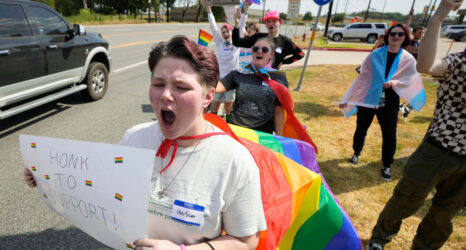Pass through the Georgia O’Keefe-inspired vagina dentata and enter a world of lesbian feminist frights. Turn to your right and you’ll find a zombie folksinger gaily crooning away, strumming an acoustic guitar beneath a shimmering sign reading “Lesbian Rule.” If you’re in need of a restroom, turn to your left and walk through a door marked either “Oppressor” or “Oppressed” (your choice).
At KillJoy’s Kastle, an interactive haunted house-style art installation currently on view in West Hollywood, Calif., every stereotype about feminists is on display—and we’re all in on the joke.
I visited the Kastle on Oct. 29 and arrived to find a long, snaking line of revelers being serenaded by an avant-garde performer with a keytar. Inside the house of horrors, “Cuntagion”—the “women’s studies class” I’d be touring the house with—met the demented professor who would be guiding us on our journey of learning and paradigm-shifting.
Beneath The Marvelous Emasculator, our guide prepared us to enter the terrifying world of lesbian feminism.
“I must warn you, you may see things that bring up past experiences or traumas,” she intoned. “And you may have your consciousness raised.”
The project, created by Toronto-based artists Deirdre Logue and Allyson Mitchell, is housed in Plummer Park’s Long Hall, a historic Spanish-style complex. Inspired in part by evangelical Christian hell houses—which typically crop up around Halloween and warn kids of “gruesome retribution for sins including fornication, suicide, occultism and, of course, same sex-relationships,” according to a press release from KillJoy’s—the performance art piece includes about a dozen different tongue-in-cheek “horrors” that poke fun at lesbian feminist stereotypes.
The first stop on our tour is a hall of warnings. Beware: You may walk away from the Kastle with cunt breath, or fall into the sinking pit of identity politics. But don’t worry, our professor tells us, there’s a processing circle at the end of the tour where we’ll have the opportunity to ask questions and share our experiences.
From there, we pass into a paranormal consciousness-raising room, where white feminists with sacks over their heads lay nude on their backs, legs kicked overhead, examining their vulvas with hand mirrors (no pictures, please). Cries of “pussy power!” ring out. Our professor explains that while consciousness raising was once a powerful tool for bringing women together, it’s been perverted by white suburban feminists “discovering themselves” through their genitals.
Next up, we meet the rainbow-unitard-clad intersectional activist, boxing her way through giant pillars of oppression: patriarchy; transphobia; and fat-shaming among them. Then it’s onto the library, where cackling riot ghouls condescend to passersby—”He hasn’t read it?!” Judgmental, high-pitched laughter explodes as we’re ushered from the room.
Perhaps the most somber atrraction is the Daddy Tank—an L.A.-specific reference to the segregated cells used by Los Angeles police in the 1950s through ’70s to hold butch and gender-nonconforming women under anti-masquerading laws. The tank was known to have the harshest conditions, and those locked up were frequently made examples of to other prisoners. We pass through, noting the endless days marked in chalk on every wall.
The next room brought up a lot of feelings for many in the group: a graveyard of lesbian feminist hallmarks, such as the Michigan Womyn’s Music Festival, The L-Word and Fresno State College’s Feminist Art Program. For some, there was a sense of heaviness and loss, while others were happy to say good riddance.
In a 2013 interview with Bitch, after showing the haunted house for the first time in Toronto, co-creator Mitchell explained that the Kastle is “not just about how lesbian feminists are monsters in the perception of the general population, but it’s also about how lesbian feminists are monsters who would rather end a movement—for example the Michigan Womyn’s Music Festival—than make any changes around how gender is perceived.”
Mitchell’s reference to the Michigan Womyn’s Music Festival, or Michfest, rings particularly true this year. After facing massive controversy for refusing to allow transwomen to attend the annual outdoor concert, Michfest—which famously allows only “womyn born womyn” to attend—announced that the 2015 gathering would be its last, just as Mitchell predicted two years ago.
Mara Keisling, executive director of the National Center for Transgender Equality, remarked on the announcement: “They have finally become extinct, like dinosaurs. But with the dinosaurs, it wasn’t something they did to themselves.” And Dana Beyer, executive director of Gender Rights Maryland, said bluntly, “While it would be unfortunate to fail to resolve this four-decade conflict directly, it would be fitting that the Michigan Womyn’s Music Festival dies a natural death, having outlived its usefulness as an exclusive club that failed to adapt.”
Back at KillJoy’s, after a heavy few moments in the graveyard, we meet a group of polyamorous vampire grannies celebrating being “Just Not Married” and offering some advice to singles everywhere: “A ring around your finger is a cage around your genitals!” Then we head into the Straw Feminist Hall of Shame, where everyone from Lena Dunham to Sarah Palin to Beyonce is skewered for spouting off faux-feminist rhetoric.
We wrap up the tour in our Processing Circle where, seated on period-blood-stained stools, we talk about how our astrological signs affect—or don’t affect—our gender expression, before heading out to Ye Olde Lesbian Feminist Gift Shoppee.
Oscillating between pointed feminist commentary and over-the-top humor, KillJoy’s Kastle offers both a crash course in recent feminist history and a careful meditation on the current state of the movement. Each room in the haunted house is skillfully crafted—quite literally, there’s plenty of knitting and crochet work to be found—by artists who clearly have an intimate understanding of the complexities of feminist theory and practice. And as a colleague who toured the Kastle with me pointed out, it’s a testament to the success of a social movement when its members feel secure enough to make fun of it. I personally left with a sense of connection, exuberance and perhaps a slightly raised consciousness. What can I say, I really did major in women’s studies.
If you live in L.A. and have plans tonight, cancel them. Friday is your last change to visit KillJoy’s—and this experience is a must.
“KillJoy’s Kastle: A Lesbian Feminist Haunted House,” runs from 6:30 p.m. to 9:30 p.m. in Plummer Park Long Hall, 1200 North Vista Street, West Hollywood, CA, 90046.
Photos by the author





